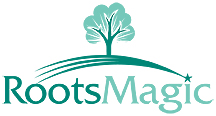RootsMagic™ – A Leader in Genealogical Software
The President, Vice President, and Genealogist of the Skillman Family Association all use RootsMagic™ to organize and store data on their respective family trees, and we heartily recommend this software to all Association members. It can be downloaded for $29.95 from the RootsMagic™ website at www.rootsmagic.com. There is also a free version, which I do not recommend, because it does not have many of the features that are described in this blog. RootsMagic™ is only available in PC format, but they are working on a Mac version.
There are many great features to RootsMagic™, most importantly the ability to record supporting documentation or data for each and every event, such as the name of the individual and the date and place of his or her birth, marriage, death and a myriad of other facts, like education, occupation, etc. Once a reference source is entered and saved, it can be reused for other individuals to whom it applies. For example, a census record, once entered, can be applied to every member of the family listed in the census without retyping the information.
Your family tree in RootsMagic™ can be viewed in several different formats and the information can be retrieved in several different ways. There is a relationship calculator to help you determine the relationship between any two individuals in your database, and the relationship to you also appears in the lower left corner of each person’s screen. If needed, you can retrieve all events that took place in a certain city, such as which Skillmans lived in Kingston, NJ?
RootsMagic™ will also form all of your events into a cogent sentence for a narrative report. For example, if John Doe was married to Jane Smith (fact) on 18 June 1865 (date) at the Dutch Reformed Church (place detail) in Franklin Park, NJ (location) by the Reverend William Vanderveer (description), RootsMagic™ will take all of these separate facts and compose them into a single sentence. There is also a media function where you can add several photos and documents pertaining to each individual.
There is a publisher function that allows you to publish your family tree in a complete book at any publisher. You can write descriptive pages, such as a dedication page, an acknowledgement page, etc. When you save your book as a PDF file, it automatically creates a table of contents. You can then take the PDF on a disk to Staples, Office Depot, FedEx Office, or any other publisher you may choose. I have recently published a book showing all of my and my wife’s direct ancestors going back ten generations. It contains an ancestor chart and a narrative report on the direct ancestors of each of us. The narrative report also includes a photo of each ancestor, if I have one. The entire book runs 82 pages and it will be a treasure for our descendants.
Importantly, RootsMagic™ is the only software certified to add and share data with FamilySearch Family Tree. RootsMagic™ software is complex enough to have all the bells and whistles you need for your family tree, but it is also fairly intuitive. When you are getting started, you should watch the various free webinars which explain particular functions of the software. If you are using another vendor’s software and are not satisfied with it, you can switch to RootsMagic™ with a GEDCOM file. I used another program for many years, but for reasons I won’t discuss here, I changed to RootsMagic™ several years ago.
RootsMagic™ is based in Utah and they have a terrific technical support desk to help you with any questions. The brains behind RootsMagic™ is Bruce Buzbee, whom I have met on a few occasions. It is a small family company that does its best to please its customers. The Skillman Family Association recommends RootsMagic™, particularly if you are just beginning to research your family tree.
John E Skillman III
President




